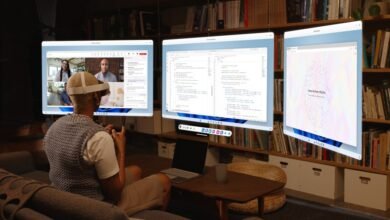Palmer Luckey’s Anduril Debuts EagleEye MR Helmet

▼ Summary
– Anduril Industries unveiled “EagleEye,” a helmeted computing system designed to turn soldiers into AI-augmented warfighters using mixed-reality technology.
– The system is modular and built on Anduril’s Lattice software, integrating command-and-control tools, sensor feeds, and AI directly into a soldier’s field of vision.
– EagleEye features live video feeds, rear and side sensors for threat alerts, real-time teammate tracking, and comes in helmet, visor, and glasses variations.
– Anduril won a $159 million award to prototype a new mixed-reality system for the Army after taking over from Microsoft’s troubled IVAS program earlier in the year.
– Anduril announced a partnership with Meta to develop extended reality devices for the military, reuniting Anduril co-founder Palmer Luckey with his former employer.
Anduril Industries has introduced a new mixed-reality helmet system named EagleEye, designed to enhance soldier capabilities through advanced AI and sensor technology. This modular family of systems integrates with the company’s Lattice software platform, delivering command-and-control tools, live sensor feeds, and artificial intelligence directly into a soldier’s visual field. The development is spearheaded by Palmer Luckey, the co-founder of Anduril who previously launched Oculus before its acquisition by Meta.
The EagleEye system incorporates multiple features intended to boost situational awareness and operational effectiveness. It can display live video streams, employ rear and side sensors to warn of incoming threats, and track the real-time locations of fellow team members. Available configurations include a full helmet, a visor, and specialized glasses, offering flexibility for different mission requirements.
This product launch occurs as the U.S. Army actively diversifies its suppliers for mixed-reality equipment. For several years, the military relied on Microsoft’s Integrated Visual Augmentation System (IVAS), a program initially valued at $22 billion. However, after encountering persistent technical and performance challenges, the Army transferred contract oversight to Anduril last February. More recently, in September, Anduril secured a $159 million award to develop a prototype mixed-reality system under the Soldier Borne Mission Command initiative. Company representatives have described this project as the most extensive effort to date aimed at equipping every soldier with enhanced perceptual and decision-making abilities.
In a noteworthy partnership development, Anduril also revealed a collaboration with Meta to create extended reality devices for military applications. This reunites Luckey with his former employer, adding a layer of industry intrigue to the venture. Luckey expressed enthusiasm about the renewed alliance, stating that his objective has always been to transform warfighters into “technomancers,” and that the joint products with Meta are a step toward realizing that vision.
The EagleEye concept is not entirely new; it originally appeared in Anduril’s earliest investor pitch materials. At the time, advisors recommended the startup concentrate on software solutions like Lattice rather than competing directly with established hardware giants. Reflecting on that period, Luckey remarked that attempting to rival firms such as Microsoft and Magic Leap would have been unrealistic. He believes circumstances have since shifted, asserting that both technology and market readiness have evolved to a point where Anduril can successfully deliver such advanced systems.
(Source: TechCrunch)


